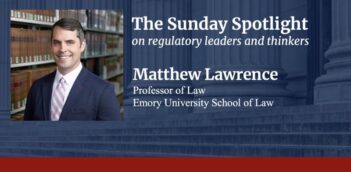
Experts discuss the role of regulations in monitoring experimental overdose prevention programs.
Overdose prevention centers, also called supervised consumption services or supervised injection facilities, provide a safe space for people to consume pre-obtained drugs under the supervision of trained staff. These staff members do not directly assist in the use or consumption of drugs. Instead, they distribute sterile supplies, test for contaminants, monitor for overdoses, and provide referrals to health care, counseling, and rehabilitative treatments.
Proponents contend that these programs represent a realistic response to the “deadliest drug crisis in U.S. history”: the opioid epidemic. For these proponents, overdose prevention centers support an effective harm reduction strategy by minimizing HIV and Hepatitis C transmission, limiting injection-related infections, promoting the safe disposal of syringes, and increasing access to medical and social services for addicted populations.
Opponents, however, view these programs as a “defeatist” response that fails to address the harm that drugs inflict on individuals and their communities.
Although there are approximately 200 overdose prevention centers operating in 14 countries around the world, none have been legally sanctioned in the United States. The U.S. Supreme Court recently let stand a decision by the U.S. Court of Appeals for the Third Circuit holding Philadelphia’s planned overdose prevention site illegal under federal law.
Nevertheless, the U.S. Department of Justice has indicated it will move forward with evaluating such programs and collaborate with state and local regulators to construct “appropriate guardrails.”
New York City has since opened two overdose prevention centers, and Rhode Island has recently approved plans for similar programs.
In this week’s Saturday Seminar, scholars explore and evaluate potential regulatory frameworks for overdose prevention centers in the United States:
- In a report issued by the Rhode Island Department of Health, Laura C. Chambers of Brown University and several coauthors explain how, in light of the highest number of accidental overdose deaths ever recorded, the state of Rhode Island passed a bill authorizing the experimental implantation of “harm reduction centers.” To inform the development of regulations that would establish minimum standards for these harm reduction centers, Chambers and her coauthors analyze the costs and benefits of a hypothetical center. Chambers and her coauthors argue that a harm reduction center located in Providence, Rhode Island providing syringe service provisions would prevent approximately two deaths and 117 inpatient hospitalizations each year, while simultaneously saving taxpayers over $1 million annually. But the center’s cost-effectiveness would ultimately depend on various factors, including its service delivery model, operational costs, and geographic location, note the Chambers team.
- In an article published in the Harm Reduction Journal, Grace H. Yoon of the Boston University School of Public Health and several coauthors study the contextual factors that impact the effectiveness and sustainability of safe consumption sites. According to the Yoon team, loosened regulations made safe consumption sites more appealing to, and thus more likely to be used by, their target populations. Conversely, more substantial internal regulations, including those prohibiting smoking or injection assistance, deterred high-risk individuals from utilizing the supervised consumption sites’ services, find Yoon and her coauthors. The Yoon team explains that innovations to improve accessibility may include longer operating hours, additional private spaces, and availability of drug-testing services.
- In a research paper issued by the International Journal of Drug Policy, Joanne Csete of the Columbia University Mailman School of Public Health and Richard Elliott of the HIV Legal Network argue that governments should provide access to safe supplies of drugs as a method of harm reduction. As fatal overdoses due to unregulated or laced drugs increase, Csete and Elliott emphasize the human rights obligation of states to protect the life and health of individuals. Existing harm reduction efforts, such as supervised consumption sites, are not strong enough to protect those who use drugs fully, argue Csete and Elliot. Governments maintaining a safe supply of drugs is the best way to avoid toxicity overdoses and protect all consumers, Csete and Elliot contend.
- In an article published in Contemporary Drug Problems, Ryan J. Lofaro and Hugh T. Miller of Florida Atlantic University explore the discussion surrounding safe injection sites, specifically in the city of Philadelphia. In their examination of social attitudes and narratives toward drug addiction, Lofaro and Miller argue that NIMBYism has challenged harm reduction efforts, particularly in the case of Philadelphia residents opposing a safe injection site in their community. Lofaro and Miller further discuss the harmful history of attributing drug use to marginalized communities, which could perpetuate “new mechanisms of discipline and surveillance.”
- In a report issued by the Manhattan Institute, Charles Fain Lehman of the Manhattan Institute explores options for local policy makers to respond to the drug overdose crisis. Lehman analyzes research on supervised consumption sites, concluding that evidence of their benefits is mixed, and highlights concerns that the literature has overlooked. For instance, Lehman warns that supervised consumption sites are likely illegal under the “Crack House Statute” of the federal Anti-Drug Abuse Act of 1986. Lehman concludes, however, that policy makers should weigh the costs and benefits of establishing supervised consumption centers and prioritize rigorous evaluation of their impact.
- In an article published in the Journal of Urban Health, Hannan M. Braun of The Warren Alpert Medical School of Brown University and Josiah D. Rich of Lifespan propose a decentralized model of supervised consumption services, whereby these services would be integrated into the locations already providing other forms of assistance to target populations. Braun and Rich contend that a decentralized model offers many benefits, including assistance for regions without geographically concentrated drug use, multiple injection access points to manage fentanyl use, lower costs, and fewer barriers to access. Rhode Island’s proposed regulations, however, make it difficult for existing facilities to become overdose prevention sites, argue Braun and Rich. As a result, they emphasize the importance of community buy-in.
The Saturday Seminar is a weekly feature that aims to put into written form the kind of content that would be conveyed in a live seminar involving regulatory experts. Each week, The Regulatory Review publishes a brief overview of a selected regulatory topic and then distills recent research and scholarly writing on that topic.



